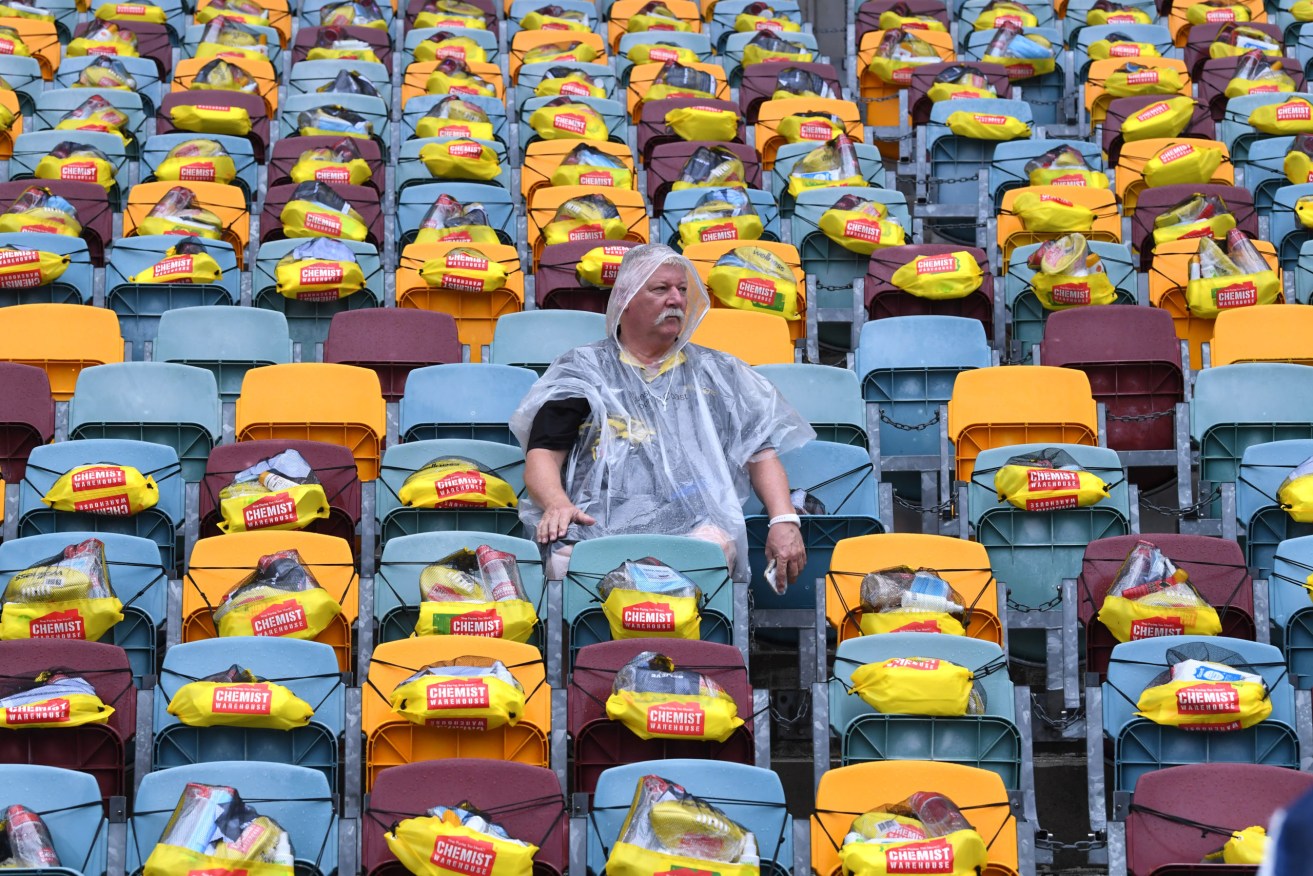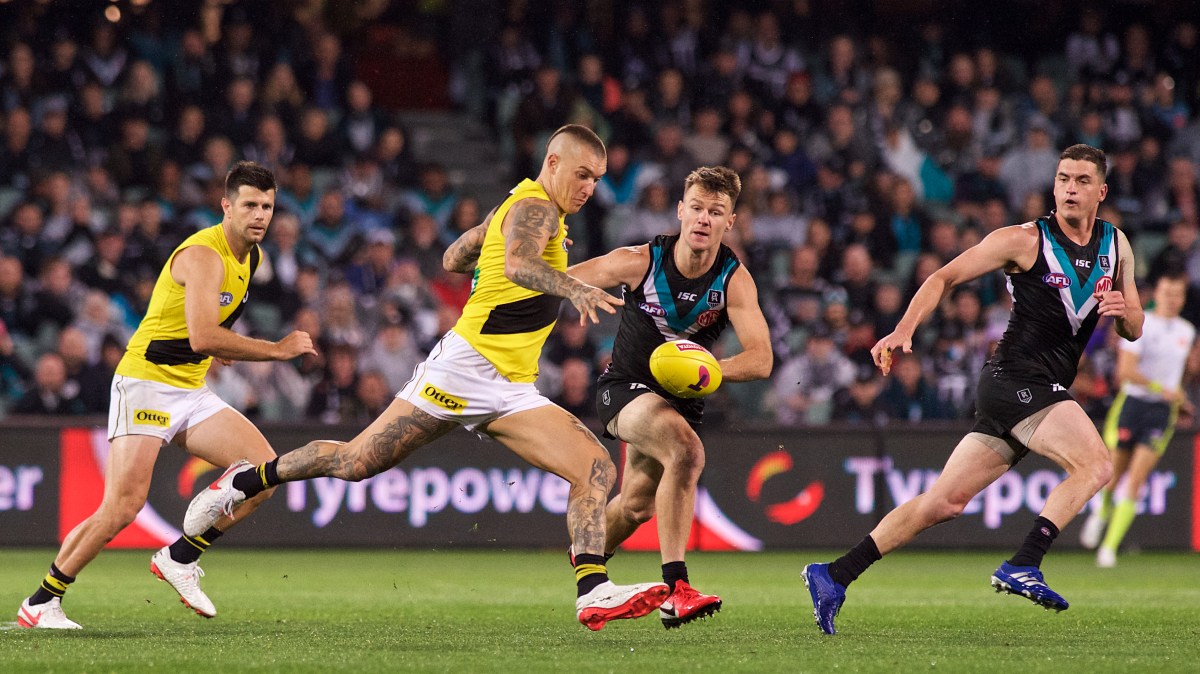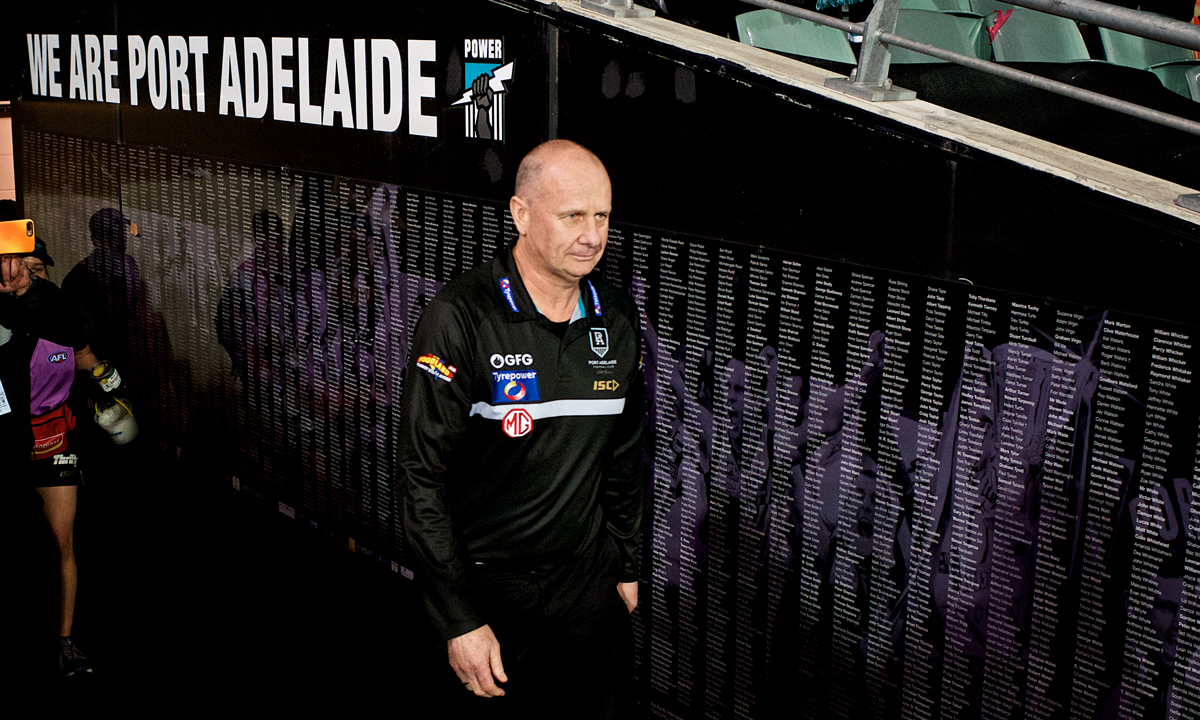Gold stars, scars and surviving the COVID-crazy 2020 footy season
A football season like none before has left a deep mark on the Australian game. Michelangelo Rucci closes his 2020 reviews for InDaily with the reflections that will linger – along with the pandemic’s cost to football.


A staffer at Brisbane's Gabba ground places gift packs on seats for the first AFL Grand Final to be played outside Victoria, due to coronavirus. Photo: AAP/Dave Hunt
SANFL president Rob Kerin said it best at his league’s grand final lunch at Adelaide Oval last month.
“There are those who would put an asterisk next to this year’s premiership winner,” noted Kerin, in reference to the questions on the validity of a season cut short and “compromised” by the COVID pandemic.
“It is not an asterisk … it is a star.”
And a gold one at that.
So hail Richmond in the AFL, Woodville-West Torrens (finally) in the SANFL, North Adelaide in the start-stop-restart SANFLW, the slow-starting Goodwood Saints in the Adelaide Footy League A1 and … no-one in the AFLW. There is an asterisk on that new AFLW honour roll, one that weighs heavily – by his own admission – on AFL boss Gillon McLachlan.
The national women’s league had its fourth premiership mothballed – at the semi-finals stage – on March 22 when McLachlan put the AFL in a 12-week lockdown while declaring COVID would have an “unprecedented impact”.
“To say,” added McLachlan, “this is the most serious threat to our game in 100 years is an understatement. It is unprecedented in its impact.”
The game immediately had its word of the moment, of the season – “unprecedented”. And it was loaded with fear, particularly if the anticipated $965 million black hole in the AFL’s finances brought into question the viability of maintaining an 18-team national men’s competition. If the season stopped and did not restart, some AFL clubs were at risk of carrying $41 million debt by the end of football’s financial year (that closes on October 31).
“We prepared for the worst – and we pretty much got most of the worst,” says McLachlan whose legacy to Australian football no longer is his early call to start up the AFLW in 2017 rather than 2020.
Seven months later – after the longest shortened season ever – Australian football did exactly as McLachlan promised when pulling down the shutters on Sunday, March 22, while West Coast and Melbourne prepared to close the nine-game opening round at Perth Stadium.
It found a way. And not for the first time.
Australian football survived through its pioneer days during the 1880s when economic depressions put the game at risk. The SA Football Association (now the SANFL) started with eight teams after 12 clubs were represented at the foundation meeting in April 1877. By 1885 there were just four combatants – South Adelaide, Norwood, Port Adelaide and Adelaide.
It made it through two World Wars in the 20th century and a Great Depression.
The game always was going to make it through. The real question was would the leagues, such as the AFL and SANFL, be still standing… or ravaged in a repeat of the 1880s?
More than money: the heavy cost of 2020
The financial cost of season 2020 is still being counted. The AFL estimates the league and 18 clubs combined have a $100 million hole – about $5-6 million at the under-performing Crows and probably $4-5 million at top-eight finalist Port Adelaide that had its revenue bonus from its 150th anniversary season wrecked by the pandemic.
The heavy tone of SANFL chief executive Jake Parkinson in his reflections on 2020 during his farewell speech on the western lawns at Adelaide Oval three weeks ago suggests the state league – after reducing debt to less than $3 million last year – is counting significant losses.
But the real cost of season 2020 is the talented people who have been cast aside in a game working to budgets cut with greater pain than inflicted by Malcolm Fraser’s razor gang in the 1980s.
As now-departed Port Adelaide Football Club chief executive Keith Thomas and Brisbane coach Chris Fagan say, the human cost to Australian football from the COVID pandemic is still truly inestimable in financial terms but most visible by the absence of quality people.
“A lot of people have lost jobs this year,” Fagan noted. “Really good people. Hopefully, in some way or another, they can find their way back in.”
“We have survived,” adds Thomas of the game that is repeatedly described as an “industry” worth billions. “The game of Australian football stood up … and it also has suffered. We have lost many good people from the game. There is a price you pay for that – and we are still to see it. You can’t reduce staff numbers by 20-40 per cent and maintain what we had built before the pandemic.”
What was the football like in 2020?

There were highlights on the field this year – Richmond and Port Adelaide providing many of them. Photo: Michael Errey/InDaily
Games were shorter, with 20-minute quarters cut to 16 (reduced by 20 per cent). This will change again in 2021, perhaps to 18. The home-and-away season was cut from 22 games for each of the 18 clubs to 17, with every team playing its rivals once. The average score in the 17-round home-and-away season was 60 points – 25 per cent down on the 80-point average of 2019.
Defence did rule. AFL coaches, in the main, preferred to set up their teams not to lose (rather than aggressively seeking the win). They protected their jobs. In the end, only one of the 18 senior coaches will not return in 2021 – novice Rhyce Shaw at North Melbourne. However, many assistant coaches are out of work in the big league while the brakes are applied to football-department spending.
The SANFL was far more attacking-minded in its football but more brutal towards coaches, with all of the bottom-four clubs – Norwood, Sturt, West Adelaide and Central District – seeking new mentors by season’s end.
The AFL coach who became most ambitious – and allowed his midfield coach to change themes during the last month of the home-and-away campaign – was the most successful. Damien Hardwick, the man Richmond fans wanted sacked at the end of 2016, collected his third premiership in four years after taking assistant coach Adam Kingsley’s proactive change-up tactics to make the Tigers more powerful at stoppages.
The AFL coach of the year – as chosen by his peers – Ken Hinkley spent the Thursday after the six-point preliminary final loss to Richmond at Adelaide Oval reviewing the last-quarter vision in his office at Alberton. He concluded he had needed to react to Richmond’s new midfield ways with more players at the contest…. Hindsight is a wonderful thing. Foresight, as Hardwick and Kingsley proved, is the winning thing.
Remarkably (or perhaps not, considering how Hawthorn premiership master Alastair Clarkson repeatedly sets the agenda beyond his clubhouse) the AFL – an organisation with a reputation for not changing rules in-season but always at the end of a campaign – tinkered with the holding-the-ball interpretation. And the umpires ignored one of the game’s first rules – the ball cannot be thrown. Front Bar presenter Andy Maher made a mockery of this on social media platform Twitter. Even Geelong superstar Patrick Dangerfield was ignoring the edict to punch the ball to constitute a handpass by the preliminary finals.
But, as is often said, this was 2020.
No crowds. Commentary teams for television and radio in studios rather than at the games. Fake crowd sounds dubbed into the telecasts and broadcasts of matches… although raucous cheering for a GWS goal scored against the Western Bulldogs at Melbourne’s empty Docklands Stadium in mid-June stretched the imagination too far – even for 2020.
The SANFL was the only state league to have its teams play its rivals twice – and now awaits rulings from the AFL to determine if (and how) the AFL reserves teams at the Crows and Port Adelaide can be restored to the state competition. The political battle for top-up players at Adelaide and Port Adelaide – while the AFL clubs work with smaller squads and the SANFL teams have their salary caps slashed from $400,000 to $210,000 – will be fascinating.
Crows versus Port
Never before has there been a bigger gap between the Crows and Port Adelaide than in 2020.
Adelaide claimed its first wooden spoon by ranking 18th after a 0-13 win-loss start. The Crows insist they are halfway through a major rebuild. Are they really two years away – or, as the critics contend, five seasons – from being a consistent competitor challenging for a top-eight finals berth?
First-time coach Matthew Nicks will hope it is two, considering his contract expires in 2022. The free-agency exit of 2019 club champion Brad Crouch to St Kilda makes the rebuilding mission a longer task, and leaves unanswered the question of why the 26-year-old midfielder found so many potholes in Adelaide.
Port Adelaide secured its fourth AFL minor premiership while ranking first from the start of the home-and-away season in March to the end of September. It won a final for the first time since 2014, beating eventual grand finalist Geelong at Adelaide Oval. Port Adelaide lost its preliminary final to back-to-back champion Richmond – adding to the 2013 and 2017 heartbreak finishes against Hawthorn and West Coast that were decided by less than a goal.
Long-serving coach Ken Hinkley is guaranteed the contract extension to next season – triggered by qualifying for this year’s AFL finals – and is assured of a new deal, perhaps as many as four years.
Both Nicks and Hinkley will be working to leaner football departments next season, with $3.5 million shaved from the previously $9.7 million allocation allowed by the AFL before clubs were subjected to a “luxury tax” for spending beyond a “soft cap”. They will have fewer players with list sizes being cut, along with the salary cap at each club from $14.5 million this year to $13.1 million next season.

Port Adelaide coach Ken Hinkley was named AFL coach of the year after guiding the Power to the minor premiership. Picture: Michael Errey/InDaily
They also will be working to new regimes in the front office.
As expected, long-serving administrator Matthew Richardson succeeds chief executive Keith Thomas. Richardson’s strong connection to the Port Adelaide membership will be invaluable at a time when the game has been handed a timely reminder of how it would be poorer without the fans.
Far from expected, former state Premier and former SANFL president John Olsen, 75, has returned to football administration to succeed Crows chairman Rob Chapman – just when it seemed Chapman would be compelled to stay on for a 14th season.
Olsen has four years at most to complete his mission to put greater emphasis on the “football” in Adelaide Football Club. In politics, Olsen was accustomed to being measured on the “first 100 days” of his reign as a newly-elected state Premier. It will be no different at West Lakes, particularly when many are anticipating change to key administrative roles. Already, but not linked to Olsen’s appointment, chief operating officer Nigel Smart has left the club after a 29-year run as an original Crows player, board member and executive.
Looking ahead
How will 2020 be remembered – and what will linger to 2021?
It is the year that tested Australian football to the limit. The game was always going to survive, but there was no certainty for clubs at all levels – and it must be remembered some country leagues never started, straining the cultural habits of small communities that thrived on the football-netball connections at weekends.
The financial cost left by the pandemic will – as in many other “industries” – take years to clear and there will be more debt in 2021 while full capacity is not allowed at venues and corporate backers are forced to review sponsorship agreements while answering to demanding shareholders.
Planning for 2021 lives on the hope of a COVID vaccine – and the fear of how quickly a “safe” location can change, as noted this week with the coronavirus community outbreak in Adelaide.
AFL football boss Steve Hocking has developed the itch again after allowing rules to stay unchanged in 2020. He has reduced interchange rotations from 90 to 75 for each team during a game and put nails in the boots of the defender standing the mark at kick-ins – more tampering in a game where the coaches have beaten the custodians at AFL House. Sadly, Hocking has not dealt with the frustration that overflowed this year with the holding-the-ball rule.
Season 2020 will be remembered as the year Australian football learned the only “stakeholder” it can rely upon is the fan. The emphatic response of supporters when asked to keep their membership money with their AFL clubs – particularly in Victoria where teams were forced to abandon Melbourne in June for hub life in Queensland, Perth and Adelaide – was reassuring.
But it is a blessing of loyalty the clubs cannot take for granted.
Usually, by late November, football fans are between eight and 12 weeks into their hibernation and have an AFL fixture for the new season on the fridge or in the shed. Some have planned trips away with AFL games built into the escape. Real estate agents know which weekends are to be avoided for auctions, particularly if there is a Saturday Showdown. Weddings are planned the same way.
But AFL executive Travis Auld, the man charged with delivering the league fixture, knows the folly of setting a full six-month calendar when the COVID pandemic could send Australian football into lockdown again, expose teams to hard borders and hubs and subject the AFL to a rolling fixture again. The second COVID wave in Adelaide today highlights how tough it is to make plans extending to October next year.
In 2021, it is reasonable to expect teams will play multiple games during trips to Perth, if only to save money. Crowds will be limited and subject to COVID protocols. Matches will have longer quarters. And, as has been the way for more than a century, the holding-the-ball rule will still draw the ire of the fans.
But there will be no asterisk against the premierships won. Just another gold star.




